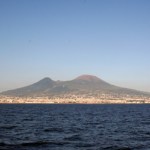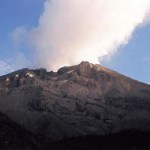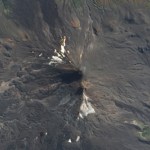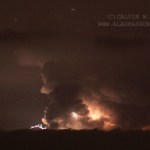Volcano Research
Drilling in Iceland lead by geologists from UC Davis hit magma this week. Image courtesy of Peter Schiffman, UC Davis.
Quick props to my officemate here at UC Davis, Naomi Marks, who happened to be part of a team (with UC Davis geology faculty Peter Schiffman and Robert Zierenberg) that drilled into active rhyolite magma in Iceland this week. Doesn't happen very often - this might be the third recorded time humans have drilled into magma - but when it does, it is very exciting. The magma was hit ~2 miles / 5 km below the surface and is likely an offshoot of a larger magmatic system nearby.…
Chaiten in Chile erupting in January 2009. Even after over a year of activity, Eruptions readers are still captivated by the volcano.
Thanks for sending me your questions about volcanoes and volcanism. I'll try to tackle some hear - but as always, keep the questions coming! Send them to
For those of you who have submitted a question but don't see the answer here, do not fret. Likely it just means that I needed to do a little more research into the question and will get to it in a later mailbag!
So, without further ado ...
Mark M.: Here in the Appalachians we have very dense crystalline rock (…
The Q&A post will be coming over the weekend (there's still time to send me a question!)
Icy cold volcanoes (well, geysers) on Enceladus, a moon of Saturn.
In the meantime, here are a few quick hits:
Mt. Cleveland in the Aleutians had a small eruption. The plume was only ~15,000 feet / ~3 km. Cleveland is one of the more active volcanoes in the Aleutians, so this eruption is not out of the norm.
Landslides and rockfalls at Arenal (in spanish) in Costa Rica continue to prompt evacuations of tourists near the volcano. It is interesting to note that officials don't seem worried about hotel…
Mt. Saint Helens in Washington state, USA
I'm back from my sojourn to New England and its time to play catch up. First things first!
There has been a lot of chatter in my inbox and on the comments here at Eruptions about the study/press release from Graham Hill's research group talking about the potential for a supervolcano forming at Mt. Saint Helens. This study (presented at the AGU Spring Meeting) was based on a magnetotelluric study of the area around (and below) Saint Helens. For those of you unfamiliar with magnetotellurics, it uses instruments that measure the magnetism and electrical…
The latest in my Volcano Profiles Series, we turn to Europe and Vesuvius. You could fill many, many volumes with the works produced on Vesuvius since Roman times. This profile will barely scratch the surface when it comes to the vast geologic and human history surrounding the volcano, but it is a start. If you want to learn more about the archaeology surrounding Vesuvius, try visiting Blogging Pompeii.
VOLCANO PROFILE: MT. VESUVIUS
Mt. Vesuvius in Italy. Image courtesy of Dario Leone.
Location: Italy
Height: 1,281 m / 4,203 ft
Geophysical location: The tectonics in the Mediterranean are very…
Here's some news bits for all you volcanophiles. Enjoy the weekend!
Ubinas in Peru steaming away in June 2007. Image courtesy of Eruptions reader Mike Lyvers.
There has been a lot of press lately on the theory that a large eruption from an ancient volcanic field in China (the 260-million-year-old Emeishan volcanic province of southwest China) could be the culprit in the grand Permian extinction. I have to admit, I've only skimmed the surface of this study, but the work lead by Dr. Paul Wignall (a paleontologist, not a volcanologist - not that there is anything wrong with that) seems to…
Things are busy - both volcanically and personally - so I'm going to just give you some links to a bunch of exciting/interesting/insane news:
West Mata erupting on May 5, 2009 in the Lau Basin.
According to a bunch of news sources, the eruption at Fernandina in the Galapagos is over (in spanish). That being said, the PNG noted that there is still a lot of carbon dioxide and sulfur dioxide being emitted, suggesting there is still a lot of degassing magma beneath the vents - at what depth (and will it erupt) is the question.
There is a lot of speculation that Nyiragongo (DRC) is erupting or…
Some brief tidbits from the volcanic realms:
Active volcanism at NW Rota-1
Kilauea? Explosive? You might think of Kilauea as a volcano that generates impressive Hawaiian-style eruptions with fire fountains reaching 100s m and dazzling lava flows, but Don Swanson at HVO sees evidence of a big explosive event at Kilauea. This eruption was ~1,000-1,600 years ago and may have produced a plinian-scale eruptive column and threw cm-scale chunks up to 17 km from the vent.
The intermingling of life and active volcanism always seems counterintuitive, but when you're talking undersea volcanism, all…
Volcano monitoring. Image courtesy of the USGS.
Last night I had the opportunity to see a talk given by YVO Scientist-in-Charge Dr. Jake Lowenstern as part of the Volcanological Society of Sacramento meeting and he gave a great talk on the state of volcano monitoring today in the U.S. He laid out a lot of details concerning the Volcano Hazards Program of the USGS and I thought I'd share some of them so we can all have an idea of the ups and downs of the VHP these days.
First off, nothing says fun like the U.S. Volcano Status Map! Apparently the dreaded watch "eye" was not meant to be a…
This is another busy Wednesday for me as the Geology Dept. at UC Davis will be hosting Dr. Jacob Lowenstern, USGS scientist and director of the Yellowstone Volcano Observatory. He will be giving the weekly seminar, along with another talk in the evening at Sacramento State as part of the Volcanological Society of Sacramento meeting (which is open to the public for those of you around Sacramento). I'm especially excited for the evening talk entitled "Domestic volcanic unrest and activity in 2009: Kilauea, Redoubt, Yellowstone and Washington, D.C.". I'll be sure to report any fun tidbits.
For…
Mt. Pinatubo, Philippines taken by STS-050 in July 1992. Image courtesy of the NASA Earth Observatory
Few websites offer so many unique views of active volcanism than the NASA Earth Observatory. That is why I'd like to wish the EO a happy 10th birthday. The website first came online April 29, 1999. Keep up the good work and here's to more stunning volcano images (like the one above of Mt. Pinatubo) to come!
One of the best resources for volcanism on the planet needs someone to run it:
National Museum of Natural History, Smithsonian Institution,
Washington D.C. anticipates hiring a distinguished scientist to become
the Director of the Global Volcanism Program and to conduct a research
program in volcanology in the Department of Mineral Sciences. As a
Federal employee, the successful candidate will be expected to serve
as Curator making major contributions to the field of volcanology
through research and publications, and to oversee the Global Volcanism
Program's documenting and reporting of the…
Mt. Baker in Washington. Image taken by John Scurlock.
Eruptions reader Robert Somerville brought to my attention the Mount Baker Volcano Research Center, a "clearinghouse for research on Mt. Baker" in Washington state. The center is a non-profit organization that is affiliated with the Geology Department at Western Washington University - and from the looks of the website, they've already done a great job in compiling a lot of information about Mt. Baker, including an excellent eruptive history of the volcano. Mt. Baker is one of the most active Cascade volcanoes, with active fumarolic…
Well, after lamenting the slow volcano news, things are beginning to pick up again. Beyond the news of a potential increase in activity at Anak Krakatau, there are a few other newsworthy bits that have come up:
Mt. Kerinci in Indonesia
Mt. Kerinci in Indonesia is showing signs of eruption. The volcano is the highest mountain on the island of Sumatra, reaching 3,800 m / 12,400 feet and last erupted in March 2008. Its volcanic activity is marked by small (VEI of ash and tephra. Currently, the volcano is experiencing increased tremors and minor explosions that rained ash on a tea plantation on…
The weekend is rolling in and I might end up spending most of it in the 90+ degree California weather, so unless something big comes up (volcanically), I'll leave you with a few news bits.
Llaima
Llaima in April 2009. Image courtesy of the NASA Earth Observatory
This is a true color image of Llaima in Chile, provided by the great folks at the NASA Earth Observatory. You can clearly see the dark grey new tephra on the main summit cone along with the grey ash covering the snow on the southwestern part of the volcano (north is up). A few other fun features are some smaller parasitic cones in…
Busy day so I probably won't get to update much as we're busy hosting Dr. Charlie Bacon, geologist for the USGS, here at UC Davis today. Dr. Bacon has written some seminal papers in his career and is probably the foremost authority of the evolution of Crater Lake/Mt. Mazama (speaking of which, >a new geologic map for the Park was recently released) and the caldera-forming eruption. He's also a really nice guy.
If you want to read some of his papers, you might try these:
Bacon, C.R., Implications of silicic vent patterns for the presence of large crustal magma chambers, in: D.P. Hill, R.A.…
Canlaon volcano, Philippines
Geothermal energy is one of those sources of energy that might be able to solve a lot of the planet's energy problems - heck, the Earth has a lot of heat it is trying to get rid of, so taking that heat and turning into energy seems like an easy (and clean?) way to stop using fossil fuels and the like. Of course, like any supposed panacea, it has its problems.
However, one aspect that gets people are riled is whether drilling into areas of active magmatism might actually cause volcanism. Just in the last few weeks, a controversy was sparked in the Philippines when…
Today looks to be a doubleheader of volcano news:
RedoubtImage courtesy of AVO/USGS, taken by Rick Wessels. An infrared image of the north slope of Redoubt showing the hot, new dome material and hot block & ash flows confined to the valley.
At 11:30 AM yesterday, AVO put Redoubt back to Orange/Watch alert status after the volcano seem to settle down to small steam/ash plumes. Less than 12 hours later (at ~6:30 AM Alaska time), the volcano produced another large explosive eruption, sending an ash column up ~50,000 feet / 15 km and producing what seems to be a significant lahar that…
Image courtesy of USGS/CVO, taken March 8, 2005 from the Cascades Volcano Observatory, Vancouver, WA
For those of you looking for something to relax with and read this weekend, you could wander over to the USGS website and download yourself a copy (for free and legally) of "A Volcano Rekindled: the Renewed Eruption of Mount St. Helens, 2004-2006" (USGS Professional Paper 1750). The report comes in at a mere 872 pages (that's 697 MB download for the whole report), but you can download the pieces that interest you most as well instead of the whole shebang.
Now, I haven't read the whole thing,…
Photo courtesy of Calvin Hall. Taken from March 28, 2009, 50 miles from Redoubt.
Redoubt continues to huff and puff, with an almost constant ash plume of ~15,000 feet / 5,000 meters. This after ~4 PM (Alaska Time), an explosion produced a 25,000 foot / 8,000 meter ash column that disrupted flights in and out of Anchorage again. Also, the air in the Kenai Peninsula area is beginning to feel the effects of the eruption, as AVO notes:
Satellite images from this morning show a broad layer of volcanic haze extending east of the volcano over the Kenai Peninsula, the Anchorage Bowl, and the…




